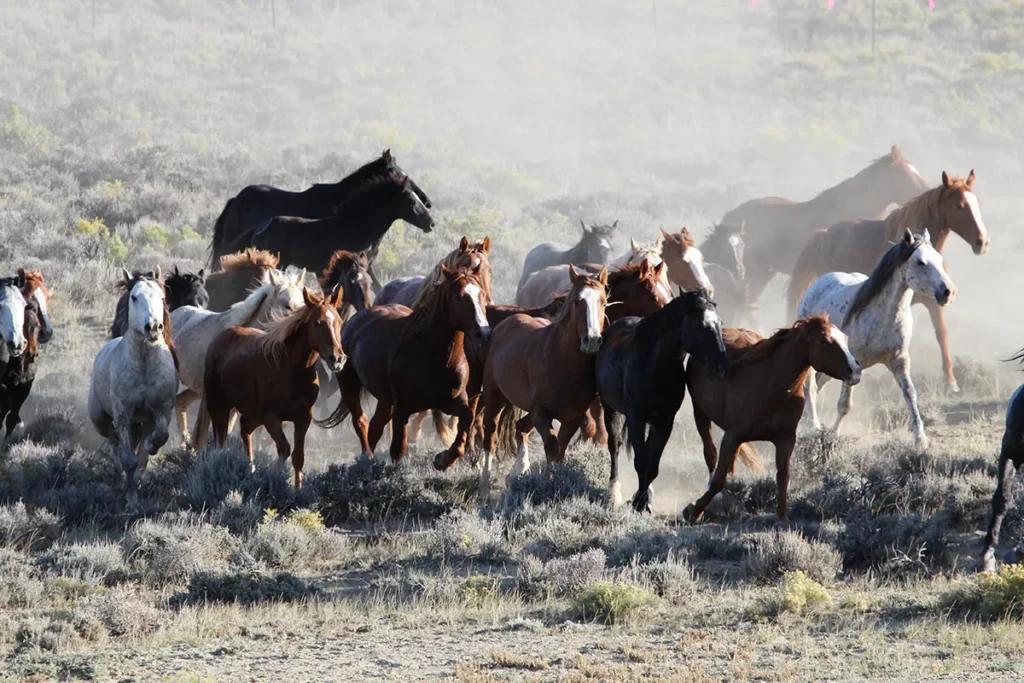
This article was originally published in Deseret News.
Horses are a classic symbol of the American story, and not just in the West. With rolling hills and a vibrant history, it’s no surprise that Virginia’s horse country is the birthplace of some of America’s first horse legends and breeds. In the American West, however, wild horses are causing a different kind of stir. A rapidly expanding wild horse population is wreaking severe ecological consequences and challenges to the animals’ welfare.
Virginia’s Chincoteague ponies, made famous by the writer Marguerite Henry, demonstrate that not all wild horses are created equal. These ponies, whose population is limited to 150 animals through annual auctions, enjoy healthier conditions compared to their Western counterparts, highlighting the stark differences in scale and management challenges.
The reality for many wild horses in the West, which number more than 73,000 across 27 million acres of federal land, is far more grim. East Coast horse enthusiasts could play a pivotal role in mitigating the wild horse crisis by adopting more of these Western mustangs, which would enhance their welfare and help preserve fragile Western ecosystems.
With Western wild horse populations nearly triple their sustainable population threshold, their health and welfare are at stake. Overcrowded ecosystems mean insufficient food and water, leading to malnutrition and dehydration. Over time, this results in weakened immune systems, increased susceptibility to disease and higher mortality rates among foals and elderly horses. In 2018, nearly 200 wild horses died of dehydration during a drought in the Navajo Nation in Arizona. These scenes are heart-wrenching: emaciated horses struggling to survive in a depleted environment that can no longer sustain them.
Furthermore, overpopulation leads to overgrazing, which in turn devastates native plant species, disrupts soil health and depletes water resources. This environmental degradation doesn’t just affect horses; it imperils the survival of wildlife species such as pronghorn and mule deer and undermines the livelihoods of ranchers who depend on these lands.
Adoption is a vital tool used by the Bureau of Land Management to help manage wild horse and burro populations. Horses and burros that have been moved off of the overcrowded Western range are adopted out of the bureau’s holding facilities into private homes. This is where East Coast adopters could make a transformative impact.
In 2019, the bureau implemented an adoption incentive program, which pays adopters $1,000 to take home a wild horse or burro. This payment can help cover the costs of veterinary care or training wild equines. Adopters pay a $125 upfront fee and must agree to not sell the animals for slaughter, have no program violations and allow inspections. After a year, once a specialist confirms proper care, adopters receive the horse title and the $1,000 incentive.
A recent report from the Property and Environment Research Center highlights the adoption incentive program’s success, noting that more than 15,000 horses and burros have found homes in the program’s first five years, easing pressure in holding facilities and ultimately on stressed rangeland ecosystems. Support for the program extends across conservation groups such as the Rocky Mountain Elk Foundation, The Wildlife Society and the Association of Fish and Wildlife Agencies.
“According to professional wildlife managers,” says Blake Henning, chief conservation officer of the Rocky Mountain Elk Foundation, “wild horses and burros exceed appropriate management levels in 86% of the herds that exist across the West. Their impact on native wildlife is devastating. Diverting these animals to private homes is the fiscally and socially responsible thing to do.”
Eastern states are uniquely positioned to assist in this effort. With their rural areas, rooted equestrian culture and a strong network of animal welfare organizations, Virginia and its neighboring states can lead by example. By stepping up as adopters, Easterners can offer a lifeline to wild horses, helping to rehabilitate Western ecosystems and ensure the well-being of these majestic animals. It’s up to all of us to help spread the word.



